History of William Carey University
The dramatic developments over the years demonstrate that William Carey University has accepted William Carey's challenging motto:
"Expect great things from God;
attempt great things for God."
W. I. Thames
1892 - 1912
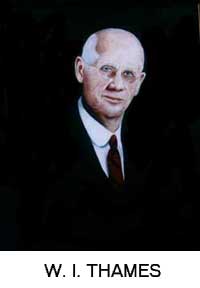
The institution that is now William Carey University had its earliest origins in Poplarville, Mississippi, when the noted educator W. I. Thames opened Pearl River Boarding School in 1892. As did many institutions of its day, Pearl River Boarding School offered "elementary, preparatory, and some college work." A disastrous fire destroyed the school in 1905, and an effort was made to obtain backing for a new school in Poplarville to be called South Mississippi College. The efforts were not successful, and Professor Thames moved to Hattiesburg where, with the backing of a group of New Orleans businessmen, he opened South Mississippi College in 1906. Little is known of Pearl River Boarding School, but South Mississippi College, under the leadership of Professor Thames as its president, quickly gained a reputation for having a strong faculty, especially in art, music, history, and home economics. After a fire destroyed the immense administration building, including classrooms, library and a 1500-seat auditorium, the young institution was forced to close.
In 1911, W. S. F. Tatum, wealthy lumberman and Methodist layman, acquired the property and offered it as a gift to the Baptists. He set two conditions: successful operation of a Christian school for girls for five years and an enrollment of at least one hundred students the first year. The property consisted of two surviving frame buildings and ten acres of cut-over land. A corporation was organized to own and control the college with nine trustees chosen from Baptist churches in Hattiesburg. In September, 1911, the school opened again with a new name, Mississippi Woman's College, under the leadership of President W. W. Rivers. In November, 1911, the debt-free college was offered to the Mississippi Baptist Convention and was accepted.
J. L. Johnson, Jr.
1912 - 1932
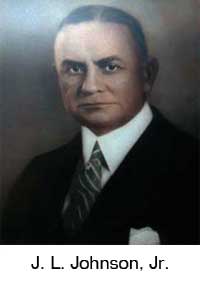
The growth of Mississippi Woman's College was a source of pride for Mississippi Baptists. Under the leadership of President J. L. Johnson, Jr., from 1912 to 1932, a splendid new administration building was completed in 1914 and named Tatum Court in honor of the college's major benefactor. New brick dormitories were added (Ross and Johnson Halls) as well as an infirmary and a model home, which was used as a laboratory for domestic science classes. During this period, the campus expanded to 40 acres.
W. E. Holcomb
1932 - 1940
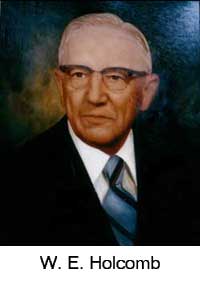
The college did not measure its progress simply with physical achievements. An early objective of Mississippi Woman's College was to train intelligent, concerned citizens who could establish Christian homes. Curricula and activities were designed with this primary objective in mind. By 1925 college stationery boldly proclaimed on its letterhead, "Mississippi Woman's College: The School with a Mission." The student body dedicated itself to the mission of the college. Such dedication accounts for Mississippi Woman's College becoming known by the late 1920s as one of the South's outstanding Christian colleges for women. Continued growth and an emphasis on missions characterized the presidency of W. E. Holcomb from 1932 to 1940.
Dr. I. E. Rouse
1946 - 1956
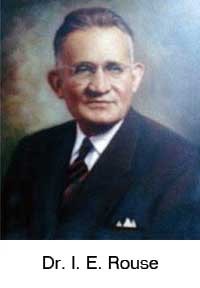
When the exigencies of the depression era forced the college to close in 1940, its facilities were used as army officers' housing for nearby Camp Shelby. In 1946 Mississippi Woman's College re-opened and underwent major renovations. Dr. I. E. Rouse was elected president in 1946 and served until 1956. In 1953 the Mississippi Baptist Convention voted to move the college into coeducational status after more than four decades of admitting only female students. This vote necessitated a new name for the institution. In 1954 the board of trustees selected the name of William Carey College in honor of the eighteenth century English cobbler-linguist whose decades of missionary activity in India earned him international recognition as the "Father of Modern Missions."
Dr. J. Ralph Noonkester
1956 - 1989
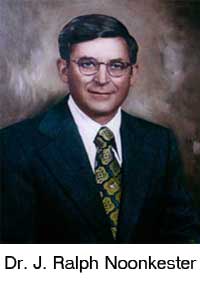
Under the leadership of Dr. J. Ralph Noonkester, who was elected president of the college in 1956, William Carey College enjoyed significant growth. In 14 years, a total of 14 new buildings rose on the Hattiesburg campus. The college attracted national attention with baseball, basketball, and tennis teams, the traveling chorale, the theatre performance groups, scientific honor societies, student mission efforts, a large number of mission volunteers, and a high percentage of acceptances to medical school. Dr. Noonkester served as president from 1956 to 1989.
In 1968 William Carey entered a new era when it announced a merger with the prestigious Mather School of Nursing in New Orleans. Another dimension opened for William Carey in 1976 when the college purchased the Gulf Coast Military Academy campus in Gulfport. Known now as William Carey University on the Coast, the 20-acre beachfront property was devastated by Hurricane Katrina in August of 2005. Classes were held off campus until 16 modular buildings were installed on the campus. Thirty acres were purchased in the 4,800-acre Tradition Planned Community, located on Highway 67, and Phase I of the new campus - William Carey University-Tradition Campus, opened August of 2009.
In June 1989 Dr. James W. Edwards was elected as the seventh president and served until 1997. Under his leadership, enrollment in church-related vocations increased, the art program at Carey on the Coast was upgraded, the college debt was restructured, salaries improved, a trimester system was inaugurated, and an MBA program in executive leadership was added to the curriculum. The Lucile Parker Gallery was opened on the Hattiesburg campus, and the Sarah Gillespie Art Gallery was upgraded and moved to Parker Hall at Carey on the Coast. A campus beautification project was inaugurated.
Dr. Larry W. Kennedy
1998 - 2006
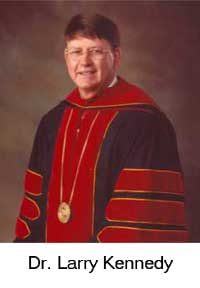
Dr. Larry W. Kennedy served as president from 1998 to 2006. Many physical improvements were made to existing facilities. New construction on the Hattiesburg campus included a nursing building, education classroom building, housing for the Center for the Study of the Life and Work of William Carey, soccer fields, an intramural field, and baseball and softball fields. Also, a new nursing building was constructed on the New Orleans Baptist Theological Seminary campus. The college's $7.5 million debt was paid off ten months ahead of schedule.
The years 2005 through 2006 brought significant challenges and advances to the institution. In the fall of 2005, all three campuses were affected by Hurricane Katrina, with the Coast campus being completely destroyed. While recovery and building efforts were underway, the trustees voted to change the status of the institution from college to university to honor its growth and enhance its potential in an increasingly global environment. The charter and all the transitions with accrediting agencies necessary for changing its status were revised. The name officially changed from William Carey College to William Carey University in 2006.
Dr. Tommy King
2007 - 2022
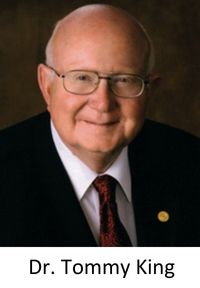
In February 2007, Dr. Tommy King was named the ninth president of the university, the first alumnus to serve in the position. Under Dr. King's leadership, the university constructed a $1M addition to the Fail-Asbury Hall on the Hattiesburg campus. Also the size of the Smith/Rouse Library was expanded by 40%, the Sarah Ellen Gillespie Museum of Art was dedicated, land was purchased for the new coast campus on which Phase I was constructed, and establishment of the William Carey University College of Osteopathic Medicine (COM) was undertaken. In December 2008, The Southern Association of Colleges and Schools raised the institution to Level V status, which permits the granting of doctoral degrees. A Master of Biomedical Science Degree was added to the degree program, and enrollment reached an all-time record high. In October of 2009 the Commission on Osteopathic College Accreditation granted provisional accreditation to the College of Osteopathic Medicine. Tennis was added to the athletic program in 2009 with cross country and women's golf added in 2010-2011. Track and field for men and women began in the fall of 2012.
In the summer of 2010, a new facilities building was occupied and the College of Osteopathic Medicine enrolled an inaugural class of 110 students. Three buildings comprise the medical complex: Academic Building, Medical Arts Building, and the Asbury Administrative Center. The Joe and Virginia Tatum Theatre was constructed in 2010. In the fall of 2010, a specialist degree in higher education administration was offered, and the career and technical education department was established. The Bachelor of Music in contemporary worship degree was added in the fall of 2011. The M.Ed. in educational leadership, Ed.D. in higher education administration, and the Ph.D. in nursing education and administration programs began in the fall of 2012.
The university is organized into the following academic units: the Ralph and Naomi Noonkester School of Arts and Letters; the School of Natural and Behavioral Sciences; the School of Business; the School of Education; the Owen and Elizabeth Cooper School of Missions and Biblical Studies; the Donald and Frances Winters School of Music; the Joseph and Nancy School of Nursing and the College of Osteopathic Medicine.
